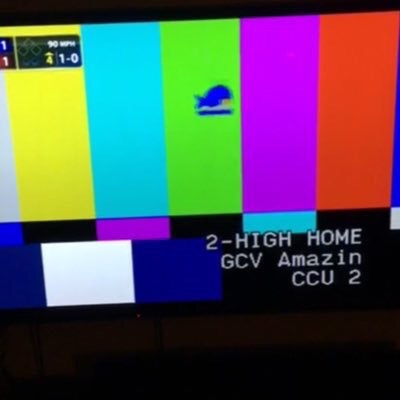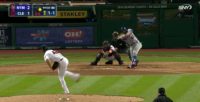Travis d’Arnaud
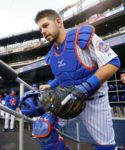
There are a number of ways to analyze Travis d’Arnaud‘s shoulder problems. It can be used as another example of the narrative that he’s injury prone. It could be used to explain his poor start at the plate. It could be used to explain why the Reds were 5/5 in stolen base attempts on Monday.
It can also be seen as another opportunity for Kevin Plawecki.
Plawecki had that chance last year, and he couldn’t take advantage. He hit .219/.280/.296 with three homers and 21 RBI. His OPS+ was 63, and his wRC+ was 60. It was about as ugly an offensive year as you could’ve had. To put it in perspective, Eric Campbell had a higher OPS+ and wRC+. You know it’s been a tough year at the plate when Campbell was the better hitter.
Now, there were valid reasons for his struggles. First, he had no protection in that lineup. The aforementioned Campbell was at one time a middle of the order bat. Second, he might not have been ready. He had played less than one season’s worth of games in AAA. Finally, he had some health issues. He had offseason sinus surgery to help alleviate the dry spells he experienced during games last year.
Whatever the reason, he struggled mightily. He was once seen as someone who could push d’Arnaud for playing time last year. Instead, his 2015 showed that d’Arnaud was clearly the better player. The Mets could’ve opted to start him in AAA this year to help his development, but ultimately, the team decided it was better to have him as a backup catcher.
Now, depending on the severity of d’Arnaud’s shoulder, Plawecki is going to get a second chance to show the Mets he can be the team’s primary catcher. He can show them he can be the .290/.364/.432 hitter he was in the minors. He has an opportunity to show his poor 2015 offensive numbers were driven by a low .277 BABIP. He can show the team he’s every bit the pitch framer d’Arnaud is. He can show the Mets he’s more durable. Possibly, Plawecki can show he’s a better player and Wally Pipp d’Arnaud in the process.
Plawecki is getting that all too valuable second chance to show the Mets he can be every bit the player they thought he was and more. He’s getting a chance to show the world what how good a ballplayer he really is. In essence, he’s getting a chance to show everyone he is better than d’Arnaud.
This time he’s in a much better lineup. He has major league playing experience. He’s had surgery to alleviate the dizzy spells. He’s out of excuses. This is his chance, and he needs to take full advantage of it.
Editor’s Note: this article was also published on metsmerizedonline.com

So far this season, two of the positive story lines, even when the team was really struggling was David Wright playing like the David Wright of old, and the continued development of Noah Syndergaard. Both were on display tonight.
Just like when Wright first came off the DL last year, he homered tonight in his first at bat in Citizen’s Bank Ballpark:
#DavidWright delivered an oppo ? in the first inning. #Metshttps://t.co/HIgn4DcI9E
— New York Mets (@Mets) April 18, 2016
He also made a nice bare-handed play in the field:
A little variation on vintage David Wright: https://t.co/Y2uGh85KEZhttps://t.co/Nx1yXyAIdS
— MLB (@MLB) April 19, 2016
The Mets needed Wright because once again runs were hard to come by against a Phillies starter. The Phillies young starters are very underrated. Tonight, it was Jerad Eickhoff. Once again, he showed a filthy 12-6 curveball. He would pitch seven innings allowing five hits, two earned, three walks, and nine strikeouts. He lowered his ERA to 1.89.
In the sixth, the Mets broke a 1-1 tie with a two out rally. Yoenis Cespedes would hit a triple, and he would score on a Lucas Duda RBI single. With Duda is struggling this year, he is hitting 4-10 with RISP. It was not the last time we would hear from Duda. For his part, Cespedes showed no ill effects from the bruised leg in the field on the basepaths.
The real mystery from tonight was how in the world the Phillies scored the one run. Syndergaard was throwing fastballs that appeared to be 101.9 MPH. His fastball was hovering around 100 MPH all night. His slider was hovering around 95 MPH all night. His change was around 90, and his curveball, or Thor’s hammer, was around 85 MPH. His stuff was once again practically unhittable.
Overall, Syndergaard pitched seven innings allowing five hits, one earned, two walks, and eight strikeouts. This actually raised his ERA to 0.90.
Once Eickhoff left the game, the Mets began to tee off against a terrible Phillies bullpen. In the eighth, Duda hit a laser to right field for his first homerun of the season.
Neil Walker would go back-to-back with an opposite field homerun to left. It was his fourth of the year. In the ninth, Wright would hit his second homerun of the game. Both were opposite field shots. They turned a tight 2-1 pitcher’s duel into a comfortable 5-1 win.
Antonio Bastardo pitched a scoreless eighth. Jeurys Familia came into a non-save situation. On the one hand, it could’ve been your typical closer struggling in a non-save situation. It also could’ve part of what has been, at least for him, a tough start to the season. Familia let up a single and double before settling down. He got the next three out, but not before allowing a run to score on a fielder’s choice. Fortunately, Familia finally shut the door before allowing a run preserving the 5-2 win.
The Mets are back to .500, and with a soft part of their schedule this week, the Mets look to be ready to take off.
Game Notes: The Mets hitters continue to strike out a lot. Tonight, they struck out 11 times. Mets have hit 23 homeruns in their last 11 games at Citizen’s Bank. Travis d’Arnaud missed the game with the bruised elbow. In the eighth, Juan Lagares was double switched into the game forcing Michael Conforto to the bench. The Mets allowed three stolen bases including two when Syndergaard was on the mound. It’s the one thing he doesn’t do well. In the fourth, when Duda popped out, a whale appeared on the screen:
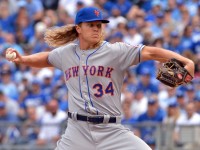
Last season, Noah Syndergaard basically dominated with a fastball/sinker, curveball, and a changeup. He tinkered with a slider, but he only threw it 3.15% of the time. After a full offseason to work on the pitch, Syndergaard announced in a big way that the pitch will be a big part of his repertoire this season.
GIF: Did we just witness @Noahsyndergaard throw a 95 MPH SLIDER?! pic.twitter.com/v5BGdNGKLp
— Nick Pollack (@PitcherList) April 5, 2016
A 95 MPH SLIDER! ARE YOU KIDDING ME!?!?!?!?
You don’t throw 95 MPH sliders with all the cheat codes on when you’re playing a video game. It’s not seemingly impossible. It is impossible. Somehow, someway Syndergaard was able to do it. Syndergaard took that pitch and took it to another level. Everyone noticed it, including Syndergaard himself as Adam Rubin reported:
“I realized in the beginning of the game I had a pretty good feel for it,” Syndergaard said. “I really took it to the next level, because I’ve never thrown a 95 MPH slider before . . . . I kind of shocked myself with how good my slider was. It felt good in spring training, but I amped it up to another level today.”
That’s an understatement. Seven of Syndergaard’s nine strikeouts came with the slider. He only had 11 strikeouts from his slider all last season. None of the Royals could hit the pitch, not even Hall of Famer George Brett – he of 3,154 hits and a career .307 batting average. As reported by Joel Sherman of the New York Post:
“There is no man alive who could’ve hit those three sliders [Syndergaard] threw to Morales,” Yost said. “I don’t think I’ve ever seen a 95-mph slider. George Brett was in here [his office] and I asked him if he could hit that, and he said no way.
After watching Syndergaard last year, we should no longer be surprised that Syndergaard has unmatched and unhittable stuff. And yet, he continues to amaze because he has a strong work ethic and a willingness to be coached. He gets better and better. He even amazed his teammates; the same people who watch him day in and day out. As David Wright said in Adam Rubin’s article:
“He had electric stuff,” captain David Wright said. “I looked up at the scoreboard and saw 94, 95. I go ask [catcher] Travis [d’Arnaud] what those pitches were, and he’s talking about sliders. That’s unheard of. That’s about as good as I’ve seen. Stuff-wise, composure-wise, for a young guy to come into this environment and throw that type of game, he’s got the ability to be a special one.
By the way, for all the talk about his new unhittable slider, Syndergaard still had his original unhittable pitches working:
Syndergaard is averaging 99.7 mph on his sinker. Not approaching. Not maxing out at. Averaging.
— Mike Petriello (@mike_petriello) April 5, 2016
As Joel Sherman reported, Alex Gordon said, “He was throwing me fastballs right down the middle, and I couldn’t catch up.” No one was catching up to the fastball. No one was making contact with the slider. Travis d’Arnaud, an exceptional receiver, even had trouble catching the pitch at times. Syndergaard now has two unhittable pitches.
We all joke that Syndergaard is really Thor, the Norse god of thunder. It’s a moniker Syndergaard fully embraces. With his other worldly stuff, at what point does this seek being a joke and start being accepted as reality?
Editor’s Note: this article was first published on metsmerizedonline.com

The worst thing that can happen to the Mets is them losing one of their pitchers for any period of time. With Matt Harvey‘s undisclosed and unknown medical situation, this fear is now a reality.
The scary part about it is how it has escalated. First, the Mets assumed he was hung over. Then, they thought it wouldn’t prevent him from making his next Spring Training start. Now, he’s flying back to New York for further examination. He’s most likely going to miss Opening Day. The players don’t know what’s going on, and they are praying for him.
The only thing we do know is Harvey’s arm is fine, or as only Terry Collins can put it, “His arm is fine! His arm is fine! Ok? His arm is fine.” This is leading to speculation as to what is wrong with Harvey, and there is no shortage of opinions.
This is because no one knows what’s happening. Part of that is HIPAA laws. Part of that is the Mets making an announcement before having all of the information. A large part of it is Harvey’s Bravo appearance and general assumptions fans have about him.
Hopefully, this is a relatively minor issue not only because of the Mets season, but more importantly, this is a man’s health we are talking about here. With that said, I’m reminded of other instances where a player’s health has postponed, derailed, or ended a player’s career.
As Mets fans, we have seen our fair share of problems. There was Ike Davis‘ bout with Valley Fever. Jose Reyes was found to have a thyroid condition. Just last year, there was David Wright and his spinal stenosis diagnosis. Elsewhere, there have been far more life threatening medical issues.
Jon Lester battled lymphoma before coming back and winning the clincher of the 2004 World Series. Brian Picolo would go from an NFL player to dying from cancer. There was also the day fifteen years ago when Magic Johnson retired from the NBA when he discovered he contracted HIV.
We don’t know what Harvey’s medical issue is. We may never know. The only thing we do know is no one wants to see something happen that will not only forever alter Harvey’s career, but also his life. So while we know his arm is alright, we don’t know if he’s alright. We don’t know what, if any effect, this will all have on his career.
Like Travis d’Arnaud and the rest of the Mets, all we can do is pray that Harvey will be alright.
Editor’s Note: this article first appeared on metsmerizedonline.com
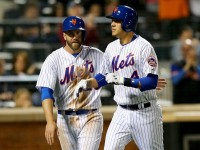
Going into the 2016 season, there was only thing missing from the roster – a backup first baseman.
However, fans were told to rest assured because there was a solution on their roster. The Mets were going to teach the position to Wilmer Flores. They were going to give a first baseman’s glove to their two catchers, Travis d’Arnaud and Kevin Plawecki. This would not only allow the team to have additional options at first, but it would also allow them to find more at bats for their two young catchers over the course of a season. Opening Day is a little over a week away. Guess how many combined games these three players have played at first base this Spring?
One.
Just one. Flores finally played a game there, and he described the experience as “weird.” He was only there because Lucas Duda couldn’t play yesterday. It’s probable Flores will get one other game there. The chances the catchers will get a game there now are slim to none. It’s just one giant wasted opportunity.
Sure, the Mets had Flores workout with Keith Hernandez at first base this Spring. In that sense, the Mets didn’t waste the time they had this Spring. However, there is just no substitute for game experience. Worst yet, they just wasted opportunities to get Flores game action at first. Marc Krauss, who shouldn’t play one game with the 2016 Mets, has played 15 games this Spring.
With so much on Flores’ plate this Spring, this was bound to happen. He had to prepare to become the main backup at each and every infield position. He had to work to become a better, more patient hitter at the plate. With David Wright‘s back, he has to be as ready as possible to play third. With Asdrubal Cabrera‘s injury coupled with Ruben Tejada‘s release, Flores had to spend time being sure he was ready to play shortstop. First base just fell by the wayside.
This all means one of three things:
- Duda is going to play 162 games;
- The Mets are comfortable with Flores at first regardless of his lack of game time there; or
- Eric Campbell is going to make the Opening Day roster.
Each passing day, it appears more and more likely that Campbell will be on the Opening Day roster. He’s played 17 games this Spring. Unlike Flores, he has played multiple games at first. Despite fans’ opinion of him, the Mets organization is bullish on Campbell’s abilities as a versatile bench player.
So, it’s most likely that the Mets have always seen Campbell as the backup first baseman. It would be the most plausible explanation why the Mets failed to expose Flores to first base for the vast majority of Spring Training. Conversely, if Campbell isn’t going to make the roster, the Mets have wasted Spring Training with respect to their inability to give Flores game action at first.
The most likely result is Eric Campbell making the Opening Day roster.
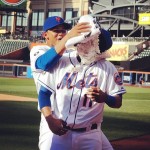
In honor of Pi Day, let’s look at all the things to look forward to during the 2016 season:
3.1 – Mike Piazza
This summer Mike Piazza is going into the Hall of Fame as a Met. He’s the first Mets position player to do so. The following weekend, he will also be the first Mets position player to have his number retired. He will forever be remembered for all of his homeruns, especially the homerun after 9/11. More importantly, he will forever be a Met.
41 – Tom Seaver
Seaver is the greatest Met to ever wear the uniform, and perhaps, the greatest right handed pitcher of all time. He was rightly dubbed “The Franchise.” With him, he began the aura of the Mets always having good pitching. This year his mantle will be picked up again by a dominant young staff reminiscent of the pitching staffs Seaver was a part of back in his day.
59 – Antonio Bastardo
Bastardo is one of a few key free agents the Mets added this offseason. Last year, the Mets had bullpen problems forcing them to overuse Jeurys Familia and trade a lot of good young pitching away to build a bullpen around the trade deadline. This year, Bastardo is a key arm in what appears to be a bullpen worthy of holding down the leads handed to them from their dominant starting pitchers.
26 – Kevin Plawecki
Plawecki had a rough 2015 whether it was because of him being rushed to the majors too soon or him needing sinus surgery. Given Travis d’Arnaud‘s injury history, it is very possible Plawecki is going to get another shot at being the Mets starting catcher next year. At some point, he will be called upon to not only continue his tremendous work as a receiver, but also being a more potent bat to the Mets lineup.
5 – David Wright
The biggest question mark in the 2015 season is how much David Wright can play and how effective he can be over the course of a 162 game season. Wright is the team leader and Captain, and they’re going to need him. At the end of 2015, he showed he can still hit and be an important part of the Mets. They’re going to need him at some point next year.
35 – Logan Verrett
After losing Verrett in the Rule 5 draft last year, he’s back with the Mets organization. Last year, he was an important swing man. He was first a bullpen arm and later a spot starter who gave a young pitching staff some rest before the postseason. In 2016, Verrett is likely to serve a similar role regardless of where he starts the year. At some point, the Mets will need him, even if it’s just to get the starters some rest before another postseason run.
89 – The Closing of a Window
After the Mets lost in the 1988 NLCS, there was no reason to believe that was the end of their window. There were veterans on the team, but there were also prospects behind them and rising stars on the team. There was still the pitching. It’s a stark reminder that when the window is open, you do everything you can in that timespan. You never know when that window closes.
79 – Paul Sewald
Sewald is just one of a number of Mets pitching prospects who are chomping at the bit to get called-up to the majors. Sewald has had a 1.83 ERA in his entire minor league career. If he continues pitching this well, he very well might get a call-up in the event there is an open bullpen spot this year.
32 – Steven Matz
In Matz’s first two career starts, he was incredible on the mound and at the plate. Even after his injuries, he has shown flashes of brilliance. He’s an early leader in the Rookie of the Year race. He’s primed to become the next great Mets starting pitcher. In 2016, he needs to stay healthy and take that next step.
38 – Dan Warthen
Warthen and the entire Mets organization have been blessed with amazing pitching. It’s encumbent upon Warthen to not only help each of these pitchers take the next step in their development, but also to help keep them healthy over the course of a full season.
4 – Wilmer Flores
We end with Flores, who was the last Mets to bat in the 2015 World Series. Flores was the player who cried at the possibility of leaving the Mets to a fan favorite. He has gone from the starting shortstop to a utility/platoon player. The 2016 Mets are a heavy left-hand hitting team. Flores can balance this out in his role as a super sub.
He’s also the first choice for third base in the event that Wright needs to sit or go on the DL for long stretches of time. He’s the primary backup at every infield position. He’s going to be an extremely important piece for the Mets.
They are all important actually. As we saw in 2015, a team will have to go deep into their roster at times. However, by building a strong 25 and 40 man roster, as the Mets have now, you give your team the best chance to make it to the postseason. Hopefully, the Mets can come full circle (pi pun) in 2016, and win the World Series.
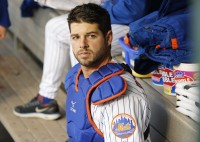
Finally, some common sense. The Mets are now talking about making Johnny Monell the back-up catcher on the Opening Day roster instead of Kevin Plawecki.
Truth be told, Plawecki is the better player right now between him and Monell. However, he’s also still considered a prospect that is going to need to receive regular at bats to get better. Remember Plawecki was a player the Mets believed could’ve challenged Travis d’Arnaud for the starting catcher spot last year. After 2015, it was clear Plawecki has more work to do offensively.
Plawecki was pressed into action when d’Arnaud got injured twice last year. In 73 games, Plawecki hit an ugly .219/.280/.296 with a 3 homeruns and 21 RBI. His OPS+ was a putrid 69, and his 60 wRC+ was just as bad. Yes, the Mets lineup at the time was historically bad, but his numbers show he was a big reason why. Simply put, Plawecki showed he was not ready for big league pitching.
Not to pile on him, but his AAA numbers suggests he shouldn’t have been called up in the first place. In 65 game in Las Vegas, Plawecki only hit .262/.318/.392. These numbers are even more troubling when you consider Cashman Field is a hitter’s park, and the Pacific Coast League is a hitter’s league. However, that’s not reason for concern. It’s reason to believe he just needs more time.
Up until his promotion to AAA in 2014, Plawecki raked. In 58 AA games, Plawecki hit .326/.378/.487 with six homers and 43 RBI. At that point, the Mets got aggressive with him and sent him to AAA where he hit .283/.345/.421 with five homers and 21 RBI in 43 games. It was 2015 when he rwall started to struggle. In the 22 games he played before getting called up to hold the fort for d’Arnaud, he was hitting .224/.267/.341. His hitting woes continued in the majors.
At this point, it should be noted that Plawecki did undergo sinus surgery in the offseason in the hopes it would cure the dizzy spells he experienced during the 2015 season. His dizzy spells could reasonably explain the precipitous drop off in his numbers. It may not. We will see in 2016.
Getting back to the 2016 season, the Mets have an option to make at backup catcher. d’Arnaud is the clear-cut starter. If healthy, he should be an All Star. If healthy, he needs to play as much as reasonably possible. For a catcher, that typically means you get days off in the following situations: (1) day game after a night game; (2) second game of a doubleheader; or (3) game after you caught a long extra inning game. There are other reasons, but those are typically the main ones. With that in mind, absent injury, your starting catcher will typical catch around 130 games.
In a 162 game season, that only leaves Plawecki with 32 games to play. For a player coming off a lost years, that will not help his development. He needs to play and see pitching. He needs to hit. If d’Arnaud gets hurt (again), Plawecki could come up from AAA and start in d’Arnaud’s spot. If Plawecki is then needed he will have been playing everyday, and he will hopefully in a nice groove instead of rotting away on the bench.
Let someone like Monell, who is getting no better, play those 32 games. Monell can hit terribly for those games. He can also prevent Plawecki from accruing service time.
Now, Plawecki is no longer a rookie due to the time he played in the majors last year. He’s also not arbitration eligible. Each day Plawecki is in the majors is another day, he’s closer to arbitration. It’s also another day the Mets lose team control of him. If you’re losing team control of him because he’s actually playing that’s understandable. However, losing control of him so he can play 30-40 games a year as a backup catcher makes no sense. It’s a mismanagement of team assets.
Keeping in the minors permits Plawecki to get the at bats he needs to improve. It also permits the Mets to keep team control. This helps Plawecki, and it helps the Mets. It permits the Mets to have more control for more years if they ever move on from d’Arnaud. It also makes Plawecki a more attractive trade option in the future. His value goes up if a team has more years of control.
In sum, Plawecki being the backup catcher helps no one. It doesn’t help him get better. It also doesn’t help the Mets maximize his value. Monell should be the backup catcher in 2016.
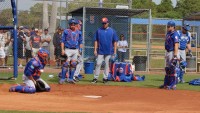
I don’t care what is happening. The Mets could be coming off a World Series appearance. The Mets could have traded everyone away in Marlins fashion. It doesn’t matter. It’s always good to see Mike Piazza with the Mets.
He’s back as a special instructor. He is there to work with Travis d’Arnaud and Kevin Plawecki. It makes sense to have a Hall of Fame catcher work with a budding All Star and prospect. Terry Collins intends gave Piazza more latitude than just working with the catchers. For example, Piazza took the time and the initiative to talk with Yoenis Cespedes about being a superstar in New York.
With his appearance at Spring Training, it did get me thinking about when and if Piazza would ever manage in the big leagues.
Right now, the Mets manager is Terry Collins, and there is no reason to believe that’s going to change soon. Collins received a two year extension. He supposedly wants to manage these next two years and then retire. The question them arises as to who the next Mets manager will be.
One trend that never seems to go away is hiring a former star to lead the team. Robin Ventura manages the White Sox. Paul Molitor manages the Twins. Ventura had no managing experience. Molitor had experience as a minor league instructor.
Piazza only has experience as the hitting coach for Team Italy. He has been well regarded in his work as the hitting coach. He has also worked with catchers and ran instructional clinics. This year has been his first year back at Spring Training with the Mets in two years. Most likely, this stint is the Mets inviting their Hall of Famer to spend time with the team. Who’s to say it can’t be more.
At one point in time, Piazza stated he envisioned returning to baseball in some capacity. He has always kept in touch with the Mets. As of right now, he’s enjoying his time, but he wants to let this team get ready for the season. He’s not overstaying his welcome. He seems content with a few days in Spring Training for now. Maybe with young children that’s all Piazza will ever want.
Two years is a long time. If Piazza wants to return to the Mets in a full time capacity, the door should always be open. No, they shouldn’t hand him a manager job. Still, there’s always room for a person with Piazza’s baseball acumen and ability to handle New York. He may just want to be a special instructor.
No matter what that future role may be, it’ll be great to see Piazza in a Mets uniform imparting his wisdom to the next generation of Mets players.
